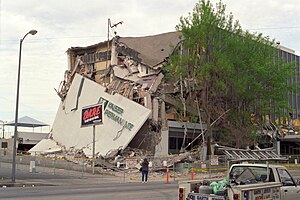


Inseismology, a buried rupture earthquake, or blind earthquake, is an earthquake which does not produce a visible offset in the ground along the fault (as opposed to a surface rupture earthquake, which does). When the fault in question is a thrust fault, the earthquake is known as a blind thrust earthquake.

Recorded ground motions of large surface-rupture earthquakes are weaker than the ground motions from buried rupture earthquakes.[1]
The asperity for a buried rupture earthquakes is in area deeper than roughly 5 kilometres (3.1 mi). Examples are the Loma Prieta earthquake, Northridge earthquake, and the Noto Hanto earthquake.[2]
As compared to the seabed surface rupture case, uplifted water outside the fault plane in buried rupture earthquakes makes for large tsunami waves.[3]
This seismology article is a stub. You can help Wikipedia by expanding it. |